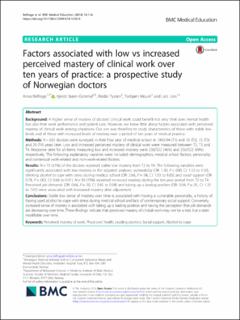| dc.contributor.author | Belfrage, Anna | |
| dc.contributor.author | Grotmol, Kjersti Støen | |
| dc.contributor.author | Tyssen, Reidar | |
| dc.contributor.author | Moum, Torbjørn Åge | |
| dc.contributor.author | Lien, Lars | |
| dc.date.accessioned | 2020-09-08T13:36:14Z | |
| dc.date.available | 2020-09-08T13:36:14Z | |
| dc.date.created | 2018-06-08T14:25:30Z | |
| dc.date.issued | 2018 | |
| dc.identifier.citation | BMC Medical Education. 2018, 18:116 (116), . | en_US |
| dc.identifier.issn | 1472-6920 | |
| dc.identifier.uri | https://hdl.handle.net/11250/2676934 | |
| dc.description.abstract | Background A higher sense of mastery of doctors’ clinical work could benefit not only their own mental health but also their work performance and patient care. However, we know little about factors associated with perceived mastery of clinical work among physicians. Our aim was therefore to study characteristics of those with stable low levels and of those with increased levels of mastery over a period of ten years of medical practice. Methods N = 631 doctors were surveyed in their final year of medical school in 1993/94 (T1) and 10 (T2), 15 (T3) and 20 (T4) years later. Low and increased perceived mastery of clinical work were measured between T2, T3 and T4. Response rates for all items measuring low and increased mastery were 238/522 (46%) and 256/522 (49%) respectively. The following explanatory variables were included: demographics, medical school factors, personality and contextual work-related and non-work-related factors. Results N = 73 (31%) of the doctors reported stable low mastery from T2 to T4. The following variables were significantly associated with low mastery in the adjusted analyses: vulnerability (OR: 1.30, P < .000, CI: 1.12 to 1.50), drinking alcohol to cope with stress during medical school (OR: 2.66, P = .04, CI: 1.03 to 6.85) and social support (OR: 0.78, P = .002, CI: 0.66 to 0.91). N = 39 (15%) reported increased mastery during the ten-year period from T2 to T4. Perceived job demands (OR: 0.66, P = .02, CI: 0.45 to 0.98) and taking up a leading position (OR: 3.04, P = .01, CI: 1.31 to 7.07) were associated with increased mastery after adjustment. Conclusions Stable low sense of mastery over time is associated with having a vulnerable personality, a history of having used alcohol to cope with stress during medical school and lack of contemporary social support. Conversely, increased sense of mastery is associated with taking up a leading position and having the perception that job demands are decreasing over time. These findings indicate that perceived mastery of clinical work may not be a trait, but a state modifiable over time | en_US |
| dc.description.abstract | Factors associated with low vs increased perceived mastery of clinical work over ten years of practice: a prospective study of Norwegian doctors | en_US |
| dc.description.sponsorship | The study was funded by the Norwegian National Advisory Unit on Concurrent Substance Abuse and Mental Health Disorders, Innlandet Hospital Trust, Norway. The Longitudinal NORDOC study has been funded by the Research Council of Norway, the Norwegian Medical Association, and the University of Oslo, Norway. | en_US |
| dc.language.iso | eng | en_US |
| dc.publisher | BMC | en_US |
| dc.rights | Navngivelse 4.0 Internasjonal | * |
| dc.rights.uri | http://creativecommons.org/licenses/by/4.0/deed.no | * |
| dc.subject | Alcohol to cope; | en_US |
| dc.subject | Leading position; | en_US |
| dc.subject | Perceived mastery of work; | en_US |
| dc.subject | Physicians’ health; | en_US |
| dc.subject | Social support. | en_US |
| dc.title | Factors associated with low vs increased perceived mastery of clinical work over ten years of practice: a prospective study of Norwegian doctors | en_US |
| dc.type | Peer reviewed | en_US |
| dc.type | Journal article | en_US |
| dc.description.version | publishedVersion | en_US |
| dc.rights.holder | This article is distributed under the terms of the Creative Commons Attribution 4.0 International License (http://creativecommons.org/licenses/by/4.0/), which permits unrestricted use, distribution, and reproduction in any medium, provided you give appropriate credit to the original author(s) and the source, provide a link to the Creative Commons license, and indicate if changes were made. The Creative Commons Public Domain Dedication waiver (http://creativecommons.org/publicdomain/zero/1.0/) applies to the data made available in this article, unless otherwise stated. | en_US |
| dc.source.pagenumber | 10 | en_US |
| dc.source.volume | 18:116 | en_US |
| dc.source.journal | BMC Medical Education | en_US |
| dc.source.issue | 116 | en_US |
| dc.identifier.doi | 10.1186/s12909-018-1236-9 | |
| dc.identifier.cristin | 1590018 | |
| cristin.unitcode | 1991,9,2,0 | |
| cristin.unitname | Avd Rusrelatert psykiatri og avhengighet | |
| cristin.ispublished | true | |
| cristin.fulltext | original | |
| cristin.qualitycode | 1 | |

